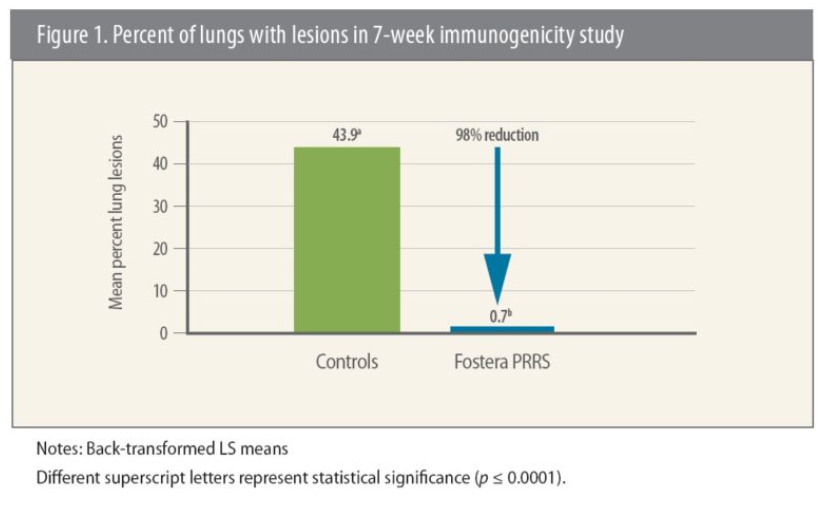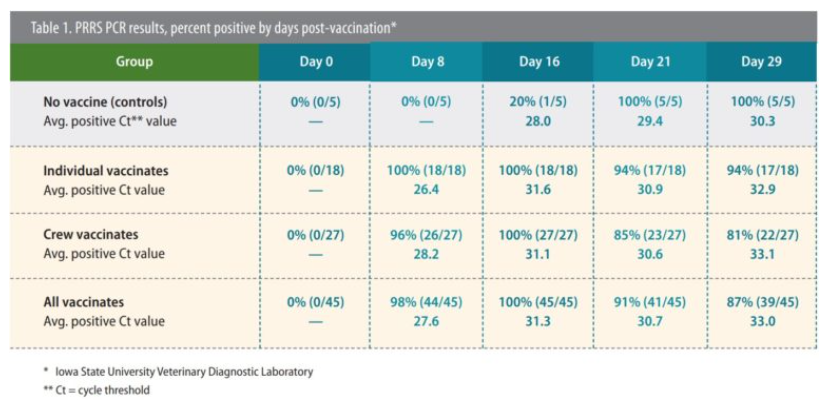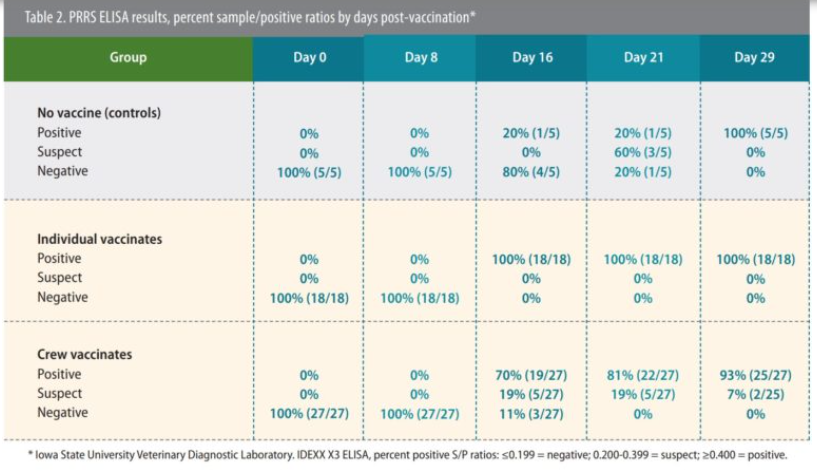



Early vaccination with Fostera PRRS, long DOI can help stem PRRS losses in growers
Vaccination as early as 1 day of age with Fostera® PRRS coupled with the vaccine’s long duration of immunity (DOI) can help pork producers stem the significant economic losses in growing pigs caused by porcine reproductive and respiratory syndrome (PRRS).
Of the nearly $581 million that PRRS costs the US pork industry annually, 62% is attributed to losses the syndrome causes in growing pigs.1,2 In addition, as the PRRS infection rate in growing pigs increases, the risk of PRRS infection on nearby sow farms appears to increase.3
“Economic losses from PRRS-induced respiratory disease in growing pigs remain such a major challenge for pork producers that it makes sense to provide protection as early as possible and for as long as possible,” according to Keith Erlandson, DVM, senior technical services veterinarian, Zoetis.
Immunogenicity demonstrated
The immunogenicity of Fostera PRRS in pigs that received the vaccine at day 1 of age was demonstrated in three concurrent, controlled challenge studies, he said.
In the first study, vaccinated pigs and unvaccinated control pigs were challenged at 7 weeks of age with the virulent PRRS virus strain NADC20. At 10 days after challenge, the signs of disease were lower, and the percentage of pigs with lung lesions was dramatically reduced in those that received Fostera PRRS compared to controls (Figure 1).4

In a second, similar challenge study, pigs were challenged with NADC20 at 18 weeks of age.5 Pigs that received Fostera PRRS had fewer clinical signs of disease. Mean lung lesion consolidation was 21.1% in the unvaccinated controls compared to only 1.0% in vaccinated pigs, a significant difference (p ≤ 0.0001).
“Put another way: Vaccination with Fostera PRRS reduced lung lesion severity by more than 95%,” Erlandson said.
26-week
DOI Pigs in the third study were challenged with NADC20 at 26 weeks of age.6 Once again, clinical signs of PRRS were less, and mean lung lesion consolidation was significantly reduced (p ≤ 0.0001) by more than 93% in vaccinated pigs compared to unvaccinated controls.
“This study demonstrated the 26-week DOI against respiratory disease provided by Fostera PRRS,” the veterinarian said.
In all the studies, pigs vaccinated with Fostera PRRS seroconverted by 22 days of age, which was the first sampling date. Vaccinated pigs also had positive antibody titers at all seven subsequent sample dates, he said.
Safety evaluated
“Vaccines not only need to be effective, they need to be safe, and the safety of Fostera PRRS in day-old pigs has also been demonstrated,” Erlandson continued.
He cited a controlled study with 300 pigs at a commercial production site in North Carolina.7 The pigs were healthy but were from a breeding herd seropositive for PRRS virus.
Each pig received either a single 2 mL intramuscular injection of Fostera PRRS or sterile water. All pigs were observed within 5 hours for any adverse reactions after injection, for 1 day after vaccination and also at 9, 14 and 22 days of age. In addition, all injection sites were observed for adverse reactions and were palpated at 2 and 9 days after vaccination.
Within 5 hours of injection, 1% of controls and 3% of vaccinates had anorexia or diarrhea.
“This rate of abnormal post-vaccination observations is low for both vaccinates and controls, which suggests no acute abnormalities could be attributed to the use of Fostera PRRS in day-old piglets,” Erlandson said. In addition, there were no injection-site reactions in the Fostera PRRS group at 1 day post-vaccination.
Impact of vaccination technique
To get the best results with Fostera PRRS, Erlandson emphasized the importance of proper vaccination technique, which was demonstrated in a study with 5,000 feeder pigs all about 8 weeks of age. The study showed the difference in post-vaccination response among pigs vaccinated by a vaccination crew versus more careful, individual pig vaccination.8
The pigs were sourced from a PRRS virus-naïve sow farm then placed in a commercial finishing operation in Iowa. The pigs were crowded in pens where a crew vaccinated them with Fostera PRRS. A few pigs were left unvaccinated, and another 18 were snared and individually vaccinated.
Polymerase chain reaction (PCR) and enzyme-linked immunosorbent assay (ELISA) results clearly demonstrated a difference in the rate of effective immunization achieved with the vaccination crew compared to individual pig vaccination (Tables 1, 2). For example, 100% of the individually vaccinated pigs were ELISA-positive by day 16 after vaccination compared to only 70% of pigs vaccinated by the crew.


By 21 days post-vaccination, 100% of the unvaccinated pigs were PCR positive. However, their seroconversion rate was low until day 29 after vaccination, when 100% were seroconverted. Erlandson notes that detection of PRRS virus circulating antibodies using ELISA typically lags behind PCR virus detection because antibody production takes time.
“These findings suggest that pigs a vaccination crew miss appear to eventually acquire PRRS protection, but it take s slightly longer for immunity to be achieved,” he commented.
Compared to experience with a previous, unvaccinated herd in the same system, vaccination with Fostera PRRS was credited with improved performance, including a reduction in mortality due to PRRS by 63% and a 19% improvement in average daily gain.
“Fostera PRRS gives producers the ability to start protecting their pigs against PRRS virus as early as day 1 of age, but it can also help finishing pigs that are confronted with a natural PRRS virus challenge later in life. These attributes along with the 26-week DOI against respiratory disease can translate into substantial savings for pork producers,” he said.
All trademarks are the property of Zoetis Services LLC or a related company or a licensor unless otherwise noted.
| References | ||||
|---|---|---|---|---|
| 1 Miller M. Annual PRRS Costs Fall $83.3 million. Producing Pork. Pork Checkoff Report. Summer 2017. | ||||
| 2 Torremorell M. Why we should focus our attention on PRRSV in growing pigs. National Hog Farmer. 2019 Nov 12. | ||||
| 3 Angulo J, Yeske P, Torremorell M. Understanding PRRSV Infection Dynamics in Growing Pigs in Control and Elimination Programs. Presented at: University of Minnesota’s Allen D. Leman Swine Conference; 2018 September 15-18; Saint Paul, Minnesota, USA. | ||||
| 4 Data on file. Study Report No. 3127R-60-11-961, Zoetis LLC | ||||
| 5 Data on file. Study Report No. 3121R-60-11-963, Zoetis LLC. | ||||
| 6 Data on file. Study Report No. 3121R-60-11-962, Zoetis LLC. | ||||
| 7 Data on file. Study Report No. B921R-US-13-142, Zoetis LLC. | ||||
| 8 Data on file. Study Report No. 12PETBIO01, Zoetis LLC. | ||||







